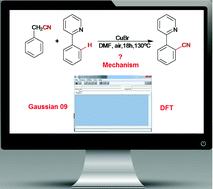Mechanism of selective C–H cyanation of 2-phenylpyridine with benzyl nitrile catalyzed by CuBr: a DFT investigation†
Abstract
The mechanism of selective C–H cyanation of 2-phenylpyridine catalyzed by CuBr was investigated using the DFT method at the B3LYP/6-31+G(d,p) level, and the integral equation formalism polarized continuum model (IEFPCM) was applied to simulate the solvent effect. The computational results suggested that 2-phenylacetonitrile can convert into benzoyl cyanide under O2 conditions via two paths (a and b), and also, 2-phenylacetonitrile can first react with the O2− anion to yield 2-hydroxy-2-phenylacetonitrile, and then 2-hydroxy-2-phenylacetonitrile goes through oxidative dehydrogenation to yield benzoyl cyanide via four different paths (c, d, e and f). The other part reaction of the conversion of 2-phenylpyridine to 2-(pyridin-2-yl)-benzonitrile catalyzed by CuBr can go through three paths (g, h and i) which involve the coordination of CN− and the N atom of 2-phenylpyridine with Cu cations, and then the processes of addition and oxydehydrogenation reactions lead to the final product 2-(pyridin-2-yl)benzonitrile. In addition, another path (j) without the participation of CuBr could also occur. The results could provide valuable insights into these types of interactions and related ones.

- This article is part of the themed collection: HOT articles in Organic Chemistry Frontiers in 2016

 Please wait while we load your content...
Please wait while we load your content...